What Does LIMS Mean? Understanding Its Role in Compliance and Efficiency
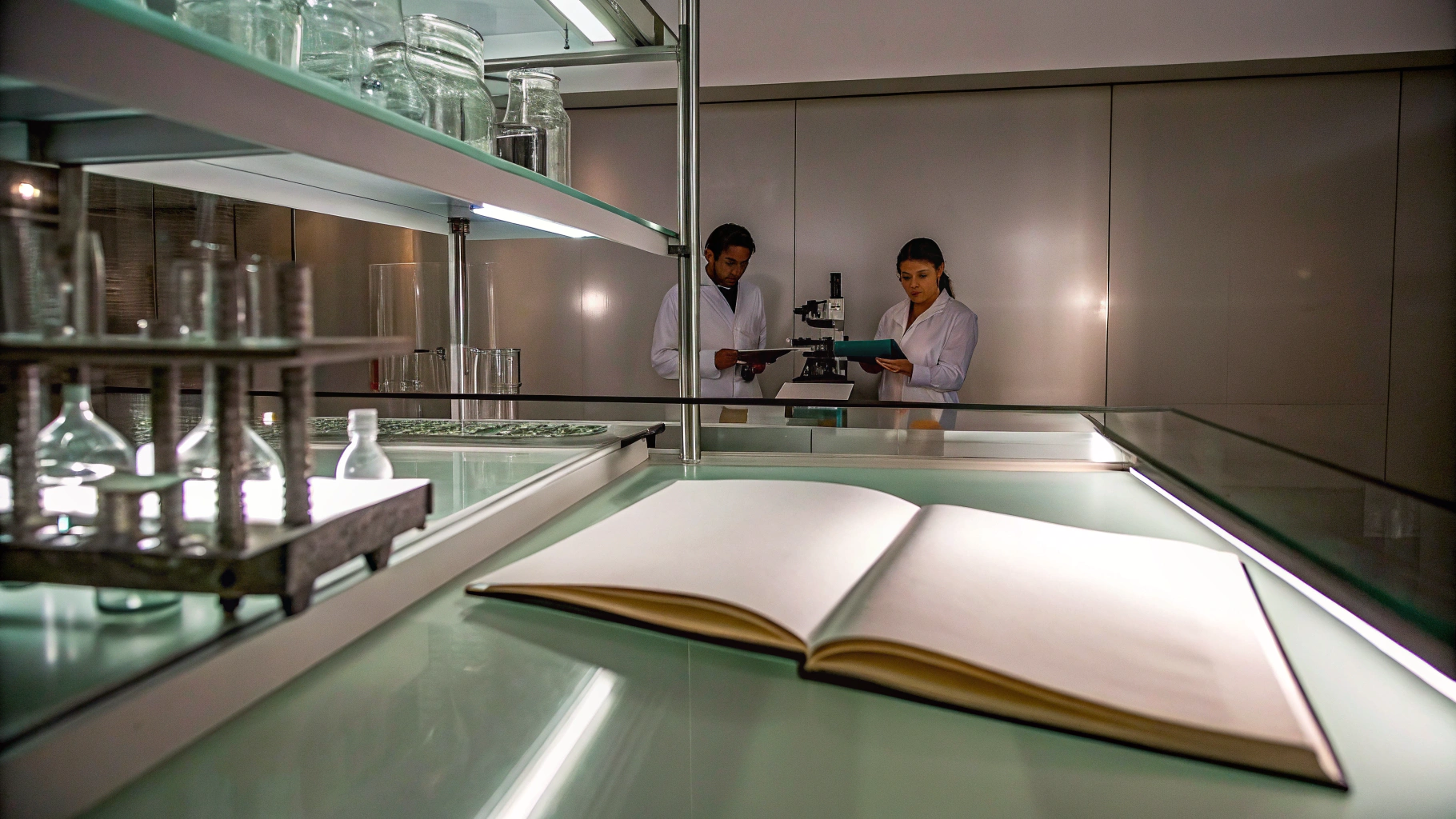
Overview
Laboratory Information Management Systems (LIMS) play a crucial role in enhancing compliance and operational efficiency within laboratories. By automating sample tracking, information management, and regulatory documentation, LIMS addresses the significant compliance challenges faced by laboratories today. Notably, these systems substantially reduce human error, improve data accuracy, and facilitate adherence to regulatory standards such as GMP and ISO. As a result, laboratories can achieve better quality control and streamlined workflows, leading to enhanced operational performance. Implementing LIMS is not merely a choice; it is a strategic move towards achieving compliance excellence and operational superiority.
Introduction
The landscape of laboratory management is rapidly evolving, driven by technological advancements that are reshaping the operations of research facilities. Central to this transformation is the Laboratory Information Management System (LIMS), a powerful tool that not only enhances compliance but also significantly boosts operational efficiency. As industries increasingly depend on these systems to meet stringent regulatory standards, a critical question arises: what implications does LIMS hold for laboratories aiming for excellence in data management and quality assurance? This exploration delves into the pivotal role of LIMS, uncovering its profound impact on laboratory operations and the essential benefits it provides in navigating the complexities of modern compliance challenges.
Define Laboratory Information Management Systems (LIMS)
An Information Management System represents an innovative software solution that streamlines the management of samples, associated information, and workflows within a research facility. By functioning as a cohesive platform, the laboratory information management system significantly enhances the efficiency and accuracy of laboratory operations through the automation of critical processes such as sample tracking, information management, and reporting, prompting the query: what does LIMS mean? In regulated environments, where adherence to standards like Good Manufacturing Practices (GMP) and ISO is paramount, knowing what LIMS means becomes indispensable. It ensures the integrity and traceability of information, both of which are vital for meeting stringent regulatory demands.
The impact of information management systems on operational efficiency is profound; research indicates that AI-driven processes within these systems can reduce the time and costs associated with advancing new molecules to the preclinical candidate phase by as much as 40% and 30%, respectively. Furthermore, the system facilitates real-time data sharing and collaboration, enabling laboratories to swiftly respond to regulatory changes and operational challenges.
Real-world examples illustrate the effectiveness of laboratory information management systems in bolstering regulatory compliance. For instance, pharmaceutical companies utilizing these systems report enhanced turnaround times and reduced compliance risks, leading to more robust quality management frameworks. As the global informatics market for laboratories is projected to experience significant growth, advancements in information management software are set to further revolutionize operations, rendering them more adaptable and compliant in 2025 and beyond.
In conclusion, the system acts as the digital backbone of modern research facilities, ensuring accuracy, traceability, and regulatory preparedness—elements that are crucial for upholding high standards within the pharmaceutical industry.
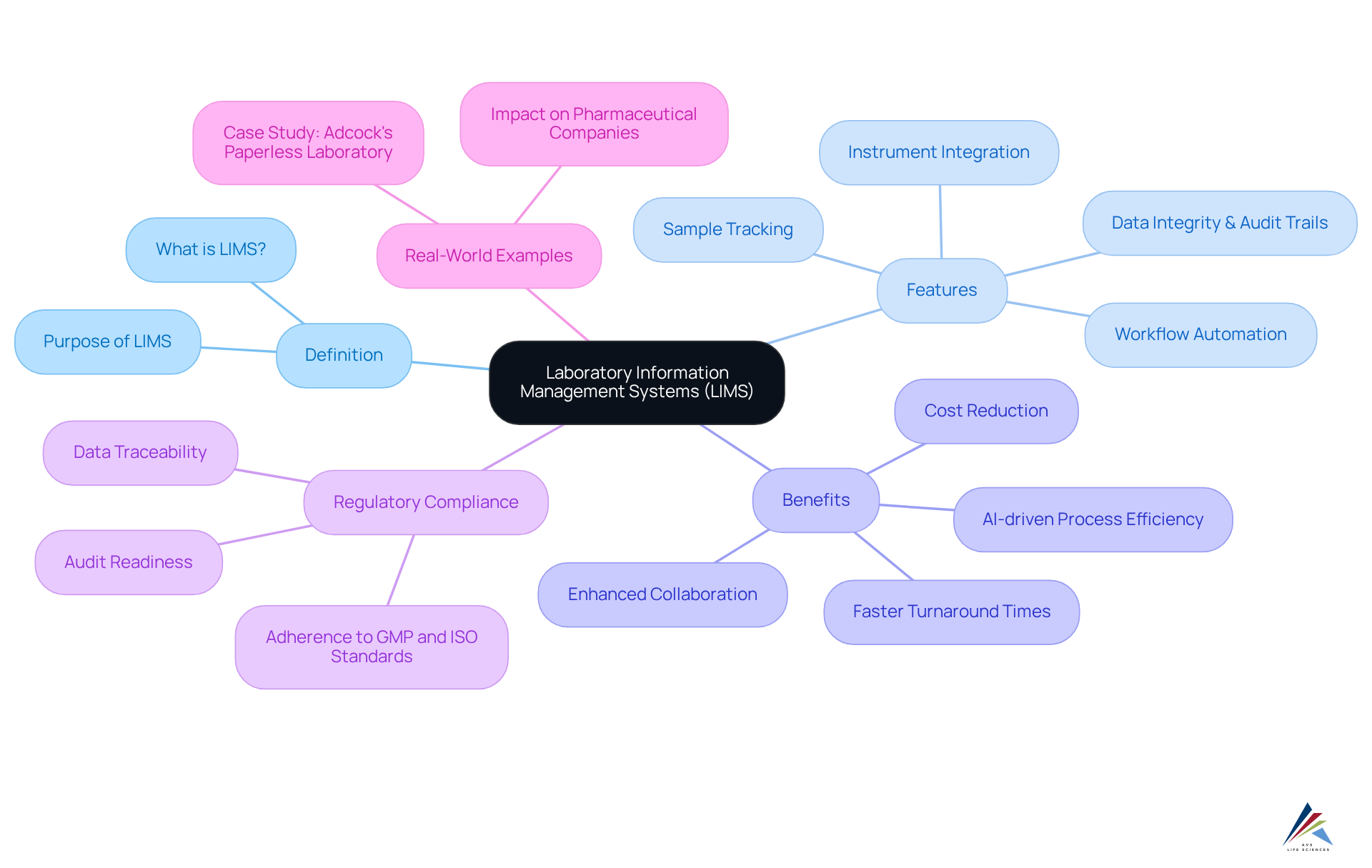
Trace the Evolution and Importance of LIMS in Laboratories
The concept of Laboratory Information Management Systems (LIMS) emerged in the late 1970s and early 1980s, leading many to ask what LIMS means in terms of laboratories' escalating need for effective information management solutions. Initially, these systems were rudimentary, focusing primarily on sample tracking and basic information entry. However, with technological advancements, laboratory information management systems have undergone significant evolution, integrating features such as inventory management, instrument integration, and compliance tracking, including adherence to GXP standards and FDA regulations. By the 1980s, the first independent laboratory information management systems were developed, automating complex information processing tasks and reducing reliance on manual record-keeping methods.
Today, many industries are asking what LIMS means, as they have become indispensable across various sectors, including pharmaceuticals, biotechnology, and environmental testing. They enhance operational efficiency by streamlining workflows, automating sample assignments, and ensuring accurate information logging. This evolution has led to a centralized data management strategy, minimizing errors and facilitating compliance with regulatory standards such as Good Manufacturing Practices (GMP) and ISO guidelines. Modern management systems come equipped with advanced features, including real-time sample monitoring and integration with electronic research notebooks (ELN), further solidifying their role in boosting productivity and compliance. The continuous advancement in laboratory information management systems technology raises the question of what LIMS means for their critical role in contemporary laboratories, enabling them to meet the stringent requirements of today's regulatory landscape.
AVS Life Sciences exemplifies the transformative impact of LIMS in the biopharmaceutical sector through its comprehensive consulting services focused on quality management and regulatory standards. A notable case study involved assisting a leading biotechnology company in upgrading their manufacturing space from a Biosafety Level 1 GMP facility to a Level 2 GMP facility. This project not only adhered to stringent FDA regulations but also highlighted the significance of robust documentation practices and data integrity. The successful transition enabled the client to manufacture essential medications while ensuring compliance with GXP standards. The insights gained from this partnership emphasize the necessity of efficient quality control strategies and the pivotal role of laboratory information management systems in facilitating these processes.
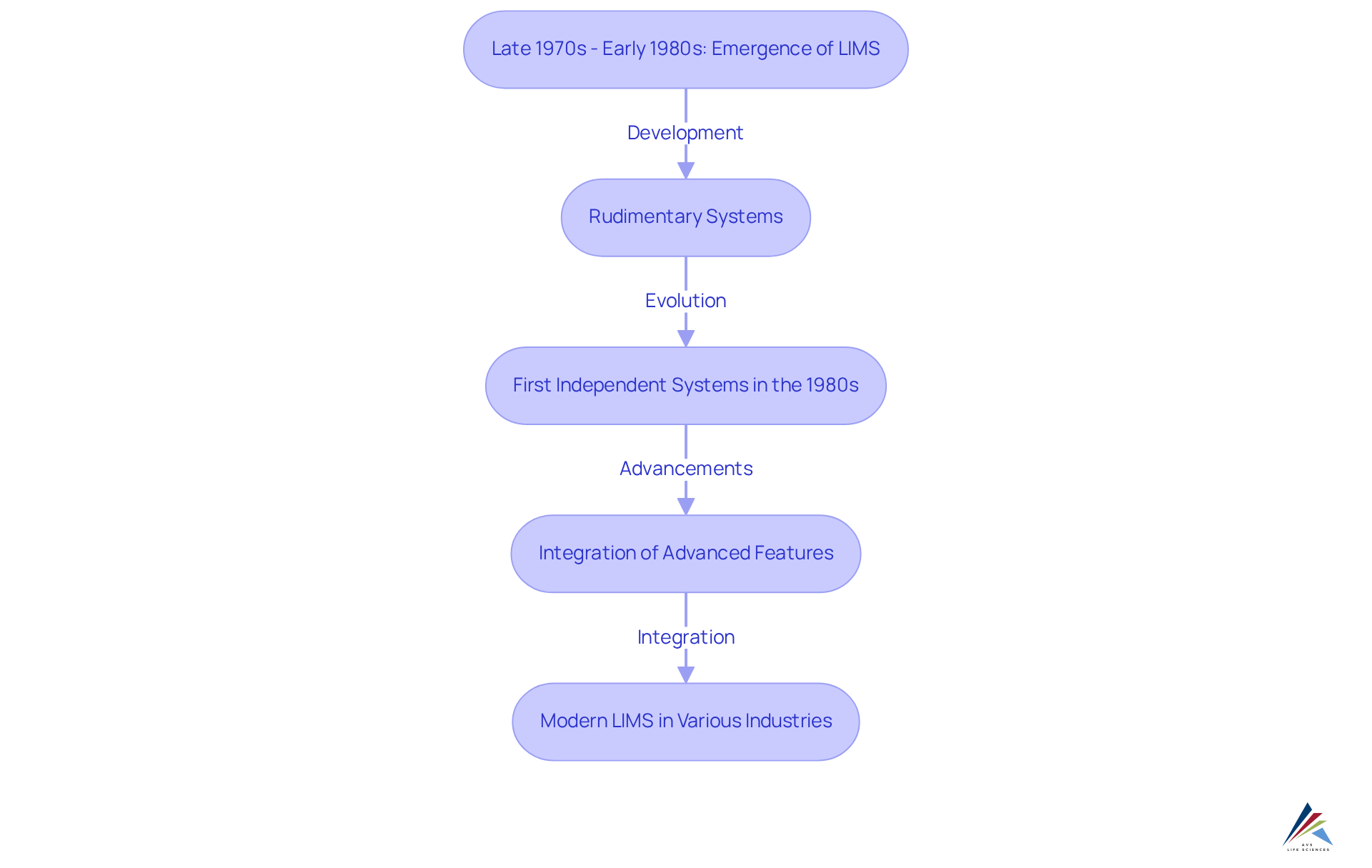
Identify Core Functions and Features of LIMS
To understand the primary roles of a Laboratory Information Management System (LIMS) in addressing compliance challenges within laboratories, one might ask, what does LIMS mean? These roles encompass:
- Sample management
- Workflow automation
- Information management
- Quality control
Sample management is crucial, as it involves meticulous tracking of samples from receipt through testing to reporting, ensuring that all information is accurately documented and readily accessible.
Workflow automation significantly boosts laboratory efficiency by streamlining processes, thereby reducing manual tasks, and minimizing potential errors.
Laboratory information management systems, often referred to as LIMS, raise the question of what LIMS means, as they empower laboratories to effectively store, retrieve, and analyze data, which is essential for informed decision-making.
Furthermore, quality control features are vital for maintaining compliance with regulatory standards, such as Good Laboratory Practices (GLP) and ISO requirements.
Typically, Laboratory Information Management Systems also integrate sophisticated reporting tools that facilitate the creation of regulatory documentation and audit trails, which are crucial in regulated environments.
Additionally, aspects related to Data Integrity Deviations, Investigations, and CAPA are integral for comprehensive regulatory management.
As emphasized by industry specialists, a well-implemented system can transform scientific operations, enhancing efficiency and compliance, leading to increased productivity and information integrity.
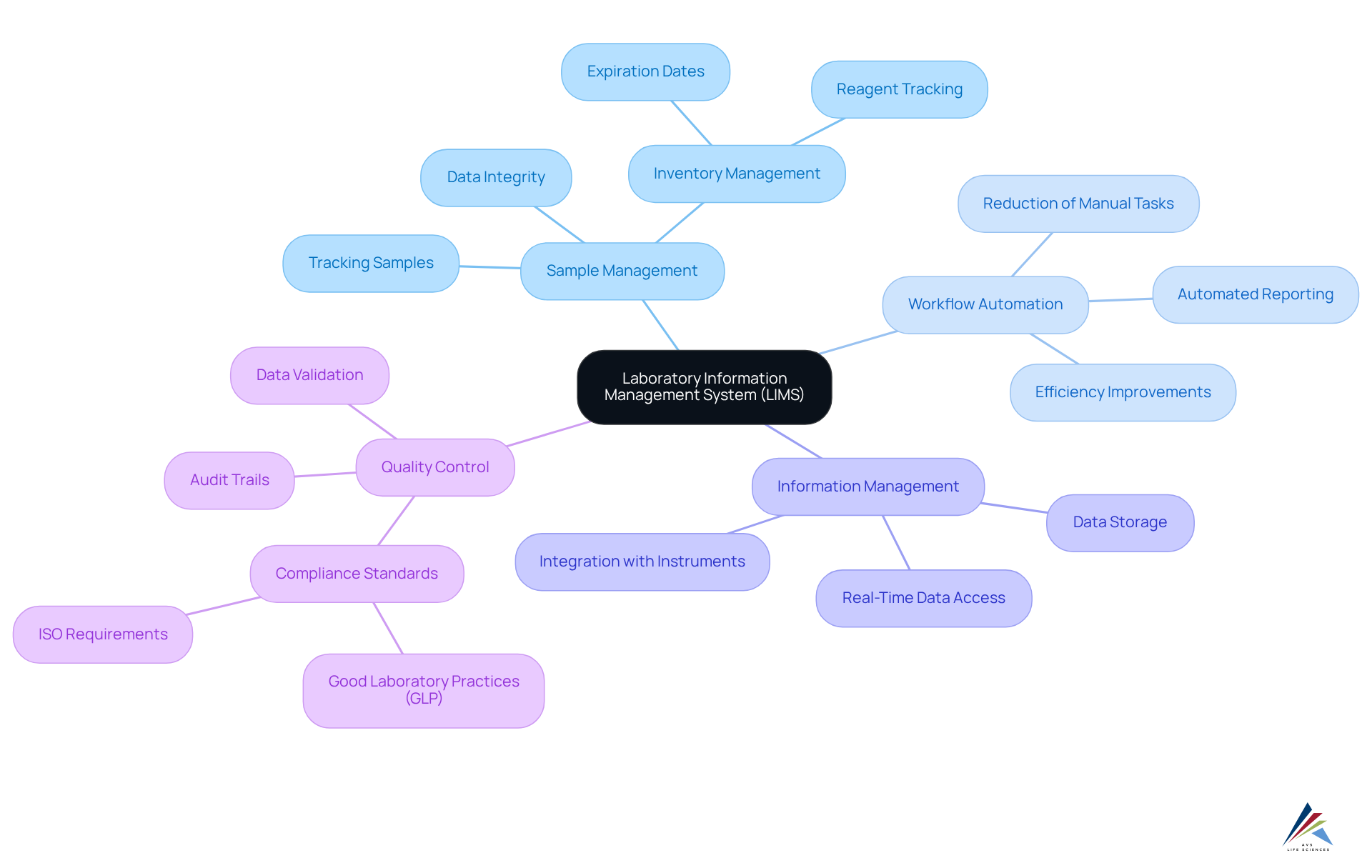
Examine the Advantages of Using LIMS for Compliance and Efficiency
Introducing a Laboratory Information Management System offers laboratories significant advantages, especially in understanding what LIMS means, as well as in regulatory adherence and operational effectiveness. One of the primary benefits is the considerable reduction of human error through automation, which markedly enhances data accuracy and reliability.
To understand what does LIMS mean, it is important to recognize that Laboratory Information Management Systems play a crucial role in fulfilling regulatory obligations by offering extensive audit trails and robust documentation features, thereby streamlining the process of demonstrating conformity with standards such as Good Manufacturing Practices (GMP) and ISO.
During this upgrade, challenges were encountered, including anomalies in test results attributed to improperly installed barcode scanner cameras, which led to valuable lessons learned. The introduction of the laboratory information management system, which raises the question of what LIMS means, significantly enhanced traceability and documentation, essential for the client’s quality assurance team.
Furthermore, information management systems optimize workflows, enabling facilities to manage samples more swiftly and efficiently. Laboratories that have integrated LIMS report substantial time savings in sample processing and data management, resulting in increased productivity and reduced operational costs. This efficiency not only bolsters compliance efforts but also nurtures a culture of continuous improvement within laboratory environments.
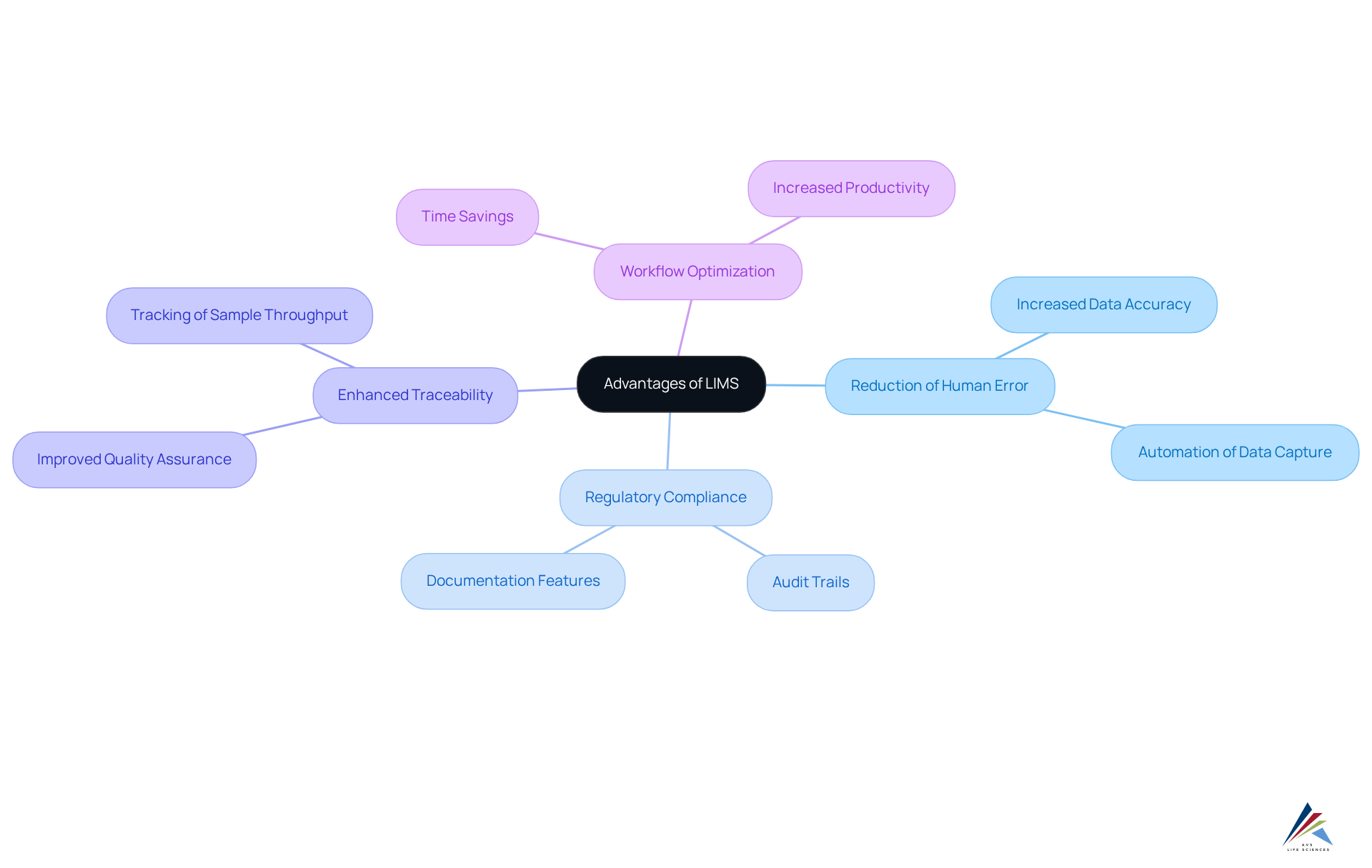
Conclusion
Laboratory Information Management Systems (LIMS) are indispensable in contemporary laboratory operations, effectively streamlining processes and ensuring adherence to rigorous regulatory standards. By automating sample tracking, data management, and reporting, LIMS significantly enhances both the efficiency and accuracy of laboratory workflows. Understanding the implications of LIMS is crucial for laboratories committed to maintaining high standards of quality and regulatory compliance in an increasingly complex environment.
This article underscores several pivotal aspects of LIMS, tracing its evolution from basic sample tracking systems to advanced software solutions that incorporate real-time monitoring, quality control, and compliance tracking. With technological advancements, LIMS not only mitigates human error but also cultivates a culture of continuous improvement, empowering laboratories to swiftly adapt to regulatory changes and operational challenges. Real-world case studies illustrate the tangible benefits organizations experience, including improved turnaround times and diminished compliance risks.
The importance of LIMS transcends mere operational efficiency; it is a vital instrument for laboratories striving to navigate the demands of today's regulatory landscape. Adopting LIMS not only boosts productivity but also guarantees that laboratories uphold the integrity and traceability of their data. As the informatics market for laboratories continues to expand, investing in sophisticated LIMS solutions will be essential for organizations aiming to thrive in the future.
Frequently Asked Questions
What is a Laboratory Information Management System (LIMS)?
A Laboratory Information Management System (LIMS) is a software solution that streamlines the management of samples, associated information, and workflows within a research facility, enhancing the efficiency and accuracy of laboratory operations.
How does LIMS improve laboratory operations?
LIMS improves laboratory operations by automating critical processes such as sample tracking, information management, and reporting, which increases operational efficiency and accuracy.
Why is LIMS important in regulated environments?
LIMS is important in regulated environments because it ensures the integrity and traceability of information, which are vital for meeting stringent regulatory demands such as Good Manufacturing Practices (GMP) and ISO standards.
What impact can LIMS have on operational efficiency?
LIMS can significantly enhance operational efficiency, with research indicating that AI-driven processes within these systems can reduce the time and costs associated with advancing new molecules to the preclinical candidate phase.How does LIMS facilitate collaboration in laboratories?
LIMS facilitates real-time data sharing and collaboration, enabling laboratories to quickly respond to regulatory changes and operational challenges.
Can you provide examples of LIMS effectiveness in regulatory compliance?
Pharmaceutical companies utilizing LIMS report enhanced turnaround times and reduced compliance risks, leading to more robust quality management frameworks.
What is the outlook for laboratory information management systems?
The global informatics market for laboratories is projected to experience significant growth, with advancements in information management software expected to further revolutionize operations, making them more adaptable and compliant in 2025 and beyond.
What role does LIMS play in the pharmaceutical industry?
LIMS acts as the digital backbone of modern research facilities in the pharmaceutical industry, ensuring accuracy, traceability, and regulatory preparedness, which are crucial for upholding high standards.
